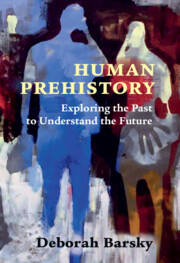
I wrote Human Prehistory: Exploring the Past to Understand the Future, to provide students with a complete and easily understandable overview of the most important stages of human anatomical, behavioral and cultural evolution. Understanding the origin story of humanity offers us a new perspective on the present-day challenges facing our species, and I aim with this book to give students the grounding and confidence to take these lessons out into the world.
In my own Prehistory classes I have found that students really connect with the material when they can see how the story of the origin of humanity links to solving our present-day problems, and I maintain this thread throughout the book. Students will come away from the book with the ability to tie together the major events in Human Prehistory and their consequences on our expansion over the planet; with special emphasis on the role of technology, communication and symbolism, as determinant aspects contributing to the uniqueness of human cognitive capacities and, ultimately, the destiny of our species.
I open the book with an introduction that explains how Human Prehistory emerged as a subject, and how our own socio-cultural contexts have shaped the discipline from the 17th century forward into modern times.
The following chapters engage students in learning basic notions about the many different fields of knowledge that form the multidisciplinary science of Human Prehistory today, and how each one contributes to finding, excavating and dating archeological sites, and to studying the different kinds of finds they yield. The book is a useful tool to assist students in gaining a thorough understanding about how and why climate changes through time, and how shifting environmental contexts affected all forms of life on Earth, shaping the past and future of our species.
In the second part of the book, I move on to defining the hominization process, explaining when, where and how we became ‘human’. All of this information is accompanied by numerous illustrations and synthetic tables, resuming the most significant evolutionary phases determining the human evolutionary pathway. Throughout the book, I explain how the emergence of the first bipedal hominins in Africa and the earliest stages of human technologies made on stone, were key events that would shape the subsequent phases of human development throughout the Paleolithic.
I decided to include ample information about the oldest phases of the Paleolithic, explaining how events detected in the archeological register were to shape nascent human culture and distinguish our own genus from all other living beings on the planet. My first-hand experience in excavating and studying archeological sites in Africa and Eurasia allowed me to give a rich synopsis of the most important chapters of human evolution, elucidating in an engaging way how the first stone-making hominins laid the groundwork for the development of culture on the worldwide stage.
The book contains up-to-date, thoroughly researched and accessible descriptions about the most important and most recent archeological finds worldwide that best illustrate each milestone in the human evolutionary process. I carefully chose concrete examples, images and tables that provide useful tools for both instructors and students wishing to grasp the key events shaping the evolution of each of the different species of hominins presently known; up to and including exciting new data about our own species- sapiens -and our various encounters through time with other forms of hominins.
This unique book will enable instructors to teach how Human Prehistory can be used to address perhaps the most important question facing contemporary generations of students: What can the past tell us about the present condition of our species and how can knowing it help us to shape a more sustainable future for all life on the planet? As we grapple with issues such as: global warming, war and terrorism, human alienation from Nature, human migrations and racism, I wanted to delve into the deep past to find ways to explain how and why humanity has arrived in its present state, moving beyond stale discourse about excavation techniques and archeology and creating a foundation for really acquiring a better understanding of what the past can tell us about what it means to be ‘human’ in our modern, globalized and digitalized world.
More from Deborah Barsky:

Was the sphere the first geometrical form made by humans? Eurasia Review, December 2023
How long has humanity been at war with itself?, Resilience, February 2024
Why Culture is not the only tool for defining Homo sapiens in relation to other Hominins, Wiki Observatory, April 2024
Watch Deborah’s Human Prehistory Book Presentation at the Museo de la Evolución Humana [Spanish language]
How Prehistoric Humans Discovered Fire Making, Popular Archaeology, May 2024
Finding the roots of religion in human prehistory Eurasia Review, June 2024
Keys to Building Human Bridges to the Past, Rozenberg Quarterly, September 2024
Digging up the roots of human culture, Daily Guardian, December 2024
Latest Comments
Have your say!